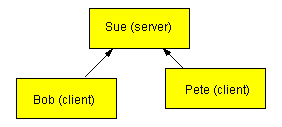Mailslots
Introduction
There are several techniques for Inter Process Communication (IPC) like DDE, pipes, atoms, sockets and mailslots. Each technique has its own characteristics; this topic concentrates on Mailslots.
Mailslots offer an easy way for a process to broadcast a message to several other processes at once. A Mailslot is a pseudo-file created by one particular process, known as the Mailslot server. The Maislot server can read messages from the mailslot.
Other processes, known as Mailslot clients, can write messages to mailslots owned by Mailslot servers. A Mailslot client is not allowed to read from another process' mailslot.
Remember: a mailslot is a pseudo-file and lives in memory only for the lifetime of the process, or shorter. Don't confuse it with email where messages are persistently stored in an "inbox folder" or file.
A simple scenario
For the sake of simplicity it's easiest to think of processes as 'computers'. It is possible to set up mailsots between processes on the same computer but this has some limitations.
In it's simplest form, a server can receive messages from one or many clients but the clients can not receive anything.

In this case, Sue has set up a mailslot on her local machine. She named this mailslot
\\.\mailslot\myapp\finance
(The "dot" means "local machine". "myapp" and "finance" are path and name to be picked by your application). This path and name have to be known by other processes. That won't be a problem if those other processes are running instances of the same application!
Bob and Pete are clients; they can write messages to Sue's mailslot by addressing
\\Sue\mailslot\myapp\finance
Where "Sue" is a machine name. More realisticly, they would address to
\\domainname\mailslot\myapp\finance
or even to
\\*\mailslot\myapp\finance
where the asterisk stands for the primary domain. In these last two cases, the messages will also be picked up by anyone else in the domain who defined the mailslot like Sue did. Hence you have a broadcasting mechanism.
A more realistic scenario
Although Sue is the mailslot server for her own local mailslot, there is no reason why she shouldn't be able to send messages to other processes who also have a local mailslot named ".\mailslot\myapp\finance". Sue can be a server and a client at the same time.
Likewise, there is no reason why Bob and Pete should't be able to serve a mailslot each, also using this same mailslot name.
A message sent by either Bob, Pete or Sue (or anyone else) will now be recieved by all others.
Limitations
Only one process on a computer can serve a mailslot with a particular name. In other words: this broadcasting mechanism will not work between multiple instances of an application running on the same computer.
The maximum size of a message is 64K if it is not broadcast. A broadcasted message can be no longer than 400 byte.
Mailslots use datagrams. There is no way of knowing if a broadcasted message will actually be received by everyone.
If you need to broadcast across a WAN you may consider setting up sockets on an "IP Multicast" enabled network. See http:www.ipmulticast.com.
Procedures
A server creates a mailslot by calling procedure CreateMailslot(). This procedure returns a Mailslot-handle. The Mailslot-handle is somewhat compatible with a file-handle: the server can read messages from the mailslot by calling procedure ReadFile(). Procedure GetMailslotInfo() tells how many messages are in the pseudo-file and how long they are. The server calls CloseHandle() to destroy the mailslot.
A client writes to a mailslot just as if it writes to a file, except the filename must be a valid mailslot-name. In other words a client uses CreateFile(), WriteFile() and CloseHandle().
Note: CreateFile() doesn't create the file of course, it only gets a handle to the existing pseudo-file (the "share"-flags are especially important here).
- Printer-friendly version
- Login to post comments
